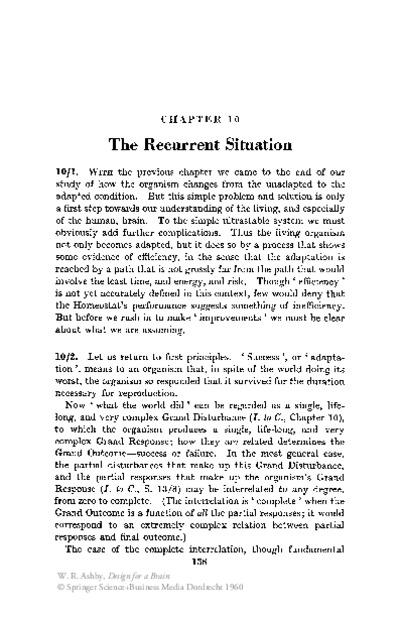The Recurrent Situation |
 |
 Diese Seite wurde seit 3 Jahren inhaltlich nicht mehr aktualisiert.
Unter Umständen ist sie nicht mehr aktuell.
Diese Seite wurde seit 3 Jahren inhaltlich nicht mehr aktualisiert.
Unter Umständen ist sie nicht mehr aktuell.
 Zusammenfassungen
Zusammenfassungen

With the previous chapter we came to the end of our study of how the organism changes from the unadapted to the adapted condition. But this simple problem and solution is only a first step towards our understanding of the living, and especially of the human, brain. To the simple ultrastable system we must obviously add further complications. Thus the living organism not only becomes adapted, but it does so by a process that shows some evidence of efficiency, in the sense that the adaptation is reached by a path that is not grossly far from the path that would involve the least time, and energy, and risk. Though ‘efficiency’ is not yet accurately defined in this context, few would deny that the Homeostat’s performance suggests something of inefficiency. But before we rush in to make ‘improvements’ we must be clear about what we are assuming.
 Dieses Kapitel erwähnt ...
Dieses Kapitel erwähnt ...
 Anderswo finden
Anderswo finden
 Volltext dieses Dokuments
Volltext dieses Dokuments
 |  The Recurrent Situation: Artikel als Volltext bei Springerlink ( The Recurrent Situation: Artikel als Volltext bei Springerlink ( : :  , 1096 kByte; , 1096 kByte;  : :  ) ) |
 Anderswo suchen
Anderswo suchen 
 Beat und dieses Kapitel
Beat und dieses Kapitel
Beat hat Dieses Kapitel während seiner Zeit am Institut für Medien und Schule (IMS) ins Biblionetz aufgenommen. Er hat Dieses Kapitel einmalig erfasst und bisher nicht mehr bearbeitet. Beat besitzt kein physisches, aber ein digitales Exemplar. Eine digitale Version ist auf dem Internet verfügbar (s.o.). Aufgrund der wenigen Einträge im Biblionetz scheint er es nicht wirklich gelesen zu haben. Es gibt bisher auch nur wenige Objekte im Biblionetz, die dieses Werk zitieren.










 Gehirn
Gehirn
 Biblionetz-History
Biblionetz-History